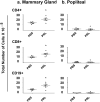Role of Prolactin in Promotion of Immune Cell Migration into the Mammary Gland
- PMID: 27900586
- PMCID: PMC5313375
- DOI: 10.1007/s10911-016-9369-0
Role of Prolactin in Promotion of Immune Cell Migration into the Mammary Gland
Abstract
Immune cells in the mammary gland play a number of important roles, including protection against infection during lactation and, after passing into milk, modulation of offspring immunity. However, little is known about the mechanism of recruitment of immune cells to the lactating gland in the absence of infection. Given the importance of prolactin to other aspects of lactation, we hypothesized it would also play a role in immune cell recruitment. Prolactin treatment of adult female mice for a period equivalent to pregnancy and the first week of lactation increased immune cell flux through the mammary gland, as reflected in the number of immune cells in mammary gland-draining, but not other lymph nodes. Conditioned medium from luminal mammary epithelial HC11 cell cultures was chemo-attractive to CD4+ and CD8+ T cells, CD4+ and CD8+ memory T cells, B cells, macrophages, monocytes, eosinophils, and neutrophils. Prolactin did not act as a direct chemo-attractant, but through effects on luminal mammary epithelial cells, increased the chemo-attractant properties of conditioned medium. Macrophages and neutrophils constitute the largest proportion of cells in milk from healthy glands. Depletion of CCL2 and CXCL1 from conditioned medium reduced chemo-attraction of monocytes and neutrophils, and prolactin increased expression of these two chemokines in mammary epithelial cells. We conclude that prolactin is an important player in the recruitment of immune cells to the mammary gland both through its activities to increase epithelial cell number as well as production of chemo-attractants on a per cell basis.
Keywords: Chemoattraction; Mammary epithelium; Migration; Milk immune cells; Prolactin.
Figures












Similar articles
-
An increase in milk IgA correlates with both pIgR expression and IgA plasma cell accumulation in the lactating mammary gland of PRM/Alf mice.J Reprod Immunol. 2012 Dec;96(1-2):25-33. doi: 10.1016/j.jri.2012.08.001. Epub 2012 Sep 25. J Reprod Immunol. 2012. PMID: 23021255
-
Migration of radiolabeled, adoptively transferred T-lymphocytes into the mammary gland and milk of lactating rats.J Reprod Immunol. 1985 Nov;8(2-3):235-48. doi: 10.1016/0165-0378(85)90043-9. J Reprod Immunol. 1985. PMID: 3879272
-
Mammary gland-specific nuclear factor activity is positively regulated by lactogenic hormones and negatively by milk stasis.Mol Endocrinol. 1992 Dec;6(12):1988-97. doi: 10.1210/mend.6.12.1491685. Mol Endocrinol. 1992. PMID: 1491685
-
New insights into the importance of prolactin in dairy ruminants.J Dairy Sci. 2016 Jan;99(1):864-74. doi: 10.3168/jds.2015-10035. Epub 2015 Nov 5. J Dairy Sci. 2016. PMID: 26547648 Review.
-
Mammary gland immunology and neonate protection in pigs. Homing of lymphocytes into the MG.Adv Exp Med Biol. 2000;480:279-86. doi: 10.1007/0-306-46832-8_32. Adv Exp Med Biol. 2000. PMID: 10959435 Review.
Cited by
-
Meningeal CGRP-Prolactin Interaction Evokes Female-Specific Migraine Behavior.Ann Neurol. 2021 Jun;89(6):1129-1144. doi: 10.1002/ana.26070. Epub 2021 Apr 22. Ann Neurol. 2021. PMID: 33749851 Free PMC article.
-
Prolactin and spermatogenesis: new lights on the interplay between prolactin and sperm parameters.Endocrine. 2023 Aug;81(2):330-339. doi: 10.1007/s12020-023-03375-x. Epub 2023 May 4. Endocrine. 2023. PMID: 37140814
-
Gut/rumen-mammary gland axis in mastitis: Gut/rumen microbiota-mediated "gastroenterogenic mastitis".J Adv Res. 2024 Jan;55:159-171. doi: 10.1016/j.jare.2023.02.009. Epub 2023 Feb 22. J Adv Res. 2024. PMID: 36822391 Free PMC article.
-
The Potential of Chicken-Herb Essence to Improve Milk Production and Infant Health in the Sprague Dawley Animal Model.Foods. 2024 May 22;13(11):1603. doi: 10.3390/foods13111603. Foods. 2024. PMID: 38890832 Free PMC article.
-
Single-Cell RNA Sequencing Reveals the Immune Landscape of Granulomatous Mastitis.Inflammation. 2025 May 8. doi: 10.1007/s10753-025-02310-8. Online ahead of print. Inflammation. 2025. PMID: 40338490
References
-
- Gouon-Evans V, Rothenberg ME, Pollard JW. Postnatal mammary gland development requires macrophages and eosinophils. Development. 2000;127(11):2269–82. - PubMed
Publication types
MeSH terms
Substances
Grants and funding
LinkOut - more resources
Full Text Sources
Other Literature Sources
Research Materials

